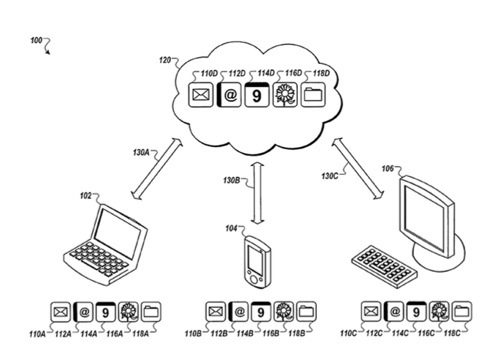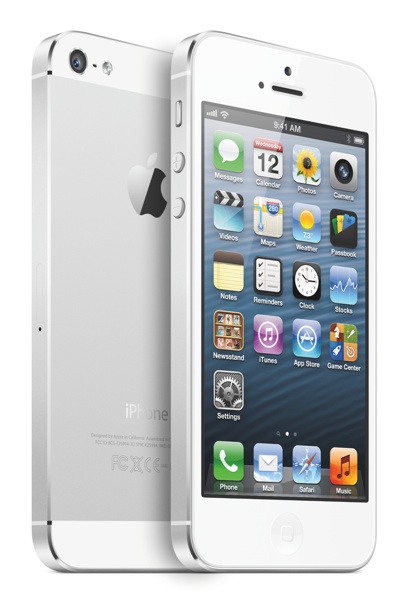Apple has been granted a patent (number 8255571) for updating multiple computing devices. It seems to involve the features of iCloud that lets you keep various types of data in sync among all other OS X and iOS devices.
The patent is for a system that system includes a server site that includes a memory for storing update data sets that correspond to data sets stored on multiple computing devices of a user. The system also includes a synchronization manager for determining that one computing device associated with the user and another computing device associated with the user are absent one or more data updates stored in the memory at the server site. The synchronization manager is configured to send in parallel, absent establishing a data transfer lock, the one or more data updates to the both computing devices of the user for updating the corresponding data stored on each computing device.
The inventors are Christopher Brooke Sharp, Karl Groethe, Andy Belk and Stuart Slack.
Here’s Apple’s background and summary of the invention: “In the ever expanding fields of personal computing and electronic devices, individuals are more frequently purchasing and using multiple computing devices for both professional and recreational applications. Often such applications rely upon a user to monitor and adjust data on each device, as changes occur. For example, a user may be required to update each of his electronic devices (e.g., a computer system, cellular telephone, etc.) when his home address changes. Along with the time and effort that an individual expends to keep the data current on each device, the individual needs to guard against accidentally causing data on multiple devices to conflict.
“Disclosed herein are systems and methods for managing the updating of data on multiple computing devices associated with a user. By allowing multiple computing devices to receive data updates absent establishing a data transfer lock with an update repository, the devices may be updated in parallel. Further, reducing the demand on the data transfer lock, allows the lock to be used to provide update data (e.g., based on user interactions) to the update repository.
“In some implementations, a system includes a server site that includes a memory for storing update data sets that correspond to data sets stored on multiple computing devices of a user. The system also includes a synchronization manager for determining that at least a first computing device associated with the user and a second computing device associated with the user are absent at least a first data update stored in the memory at the server site, the synchronization manager is configured to send in parallel, absent establishing a data transfer lock, the at least first data update to the first computing device and the second computing device of the user for updating the corresponding data stored on each computing device.
“In other implementations, a system includes first computing device associated with a user. The first computing device includes a memory for storing update data sets to update corresponding stored data sets. The first computing device also includes a synchronizer for determining that the first computing device is absent at least a first data update stored at a server site. The synchronizer is configured to receive the at least first data update from the server site absent establishing a data transfer lock and in parallel with a second computing device receiving the at least first data update absent of establishing a data transfer lock.
“In other implementations, a method includes determining that at least a first computing device associated with a user and a second computing device associated with the user are absent at least a first data update stored at a server site. The method also includes, in parallel, sending the at least first data update from the server site to the first computing device and to the second computing device of the user to update corresponding data stored on each computing device. Sending the at least first data update occurs absent establishing a data transfer lock.
“In other implementations, a method includes determining that at least a first and a second computing device associated with a user are absent at least a first data update stored at a server site. The method also includes, in parallel, receiving the at least first data update from the server site at the first computing device and the second computing device of the user to update corresponding data stored on each computing device, wherein receiving the at least first data update occurs absent establishing a data transfer lock.
“In other implementations, one or more computer readable media store instructions that are executable by a processing device, and upon such execution cause the processing device to perform operations that include determining that at least a first computing device associated with a user and a second computing device associated with the user are absent at least a first data update stored at a server site. Execution of the instructions also cause the processing device to perform operations that include, in parallel, sending the at least first data update from the server site to the first computing device and to the second computing device of the user to update corresponding data stored on each computing device, wherein sending the at least first data update occurs absent establishing a data transfer lock.
“In still other implementations, one or more computer readable media store instructions that are executable by a processing device, and upon such execution cause the processing device to perform operations that include determining that at least a first and a second computing device associated with a user are absent at least a first data update stored at a server site. Execution of the instructions also cause the processing device to perform operations that include, in parallel, receiving the at least first data update from the server site at the first computing device and the second computing device of the user to update corresponding data stored on each computing device, wherein receiving the at least first data update occurs absent establishing a data transfer lock.
“These and other aspects and features and various combinations of them may be expressed as methods, apparatus, systems, means for performing functions, program products, and in other ways.”
Apple has also been granted the following patents:
° Patent number 8255670 for replay reduction for power savings.
° Patent number 82556005 for a method and apparatus to prevent hacking of encrypted audio or video content during playback.
° Patent number 8259078 for liquid-crystal display (LCD) touch screens that integrate the touch sensing elements with the display circuitry.
° Patent number 8260079 for systems and techniques for processing sequences of video images involve receiving, on a computer, data corresponding to a sequence of video images detected by an image sensor.
° Patent number 8260877 for methods and apparatuses provide real-time or near real-time streaming of content using transfer protocols such as an HTTP compliant protocol.
° Patent number 8261246 for a method and system for dynamically populating groups in a developer environment.
° Patent number 8261209 for updating content based on cursor position.
° Patent number 8261197 for methods and systems for managing To do items and/or notes and/or emails (or other electronic messages).
° Patent number 8261191 for a a method that presents a preview of a set of images in a graphical user interface (GUI) of a device.
° Patent number 8261186 a method for defining structure for an unstructured document that includes a number of primitive elements that are defined in terms of their position in the document.
° Patent number 8261026 for improved approaches to manage cache data for applications operating in a data center environment.
° Patent number 8261877 for methods and apparatuses provide real-time or near real-time streaming of content using transfer protocols such as an HTTP compliant protocol.
° Patent number 8260640 for systems and methods are provided for generating context-based movie information. For example, a movie application on an electronic device can obtain show times of a movie from multiple movie theaters.
° Patent number 8260320 for obtaining location specific content.
° Patent number 8260079 for systems and techniques for processing sequences of video images involve receiving, on a computer, data corresponding to a sequence of video images detected by an image sensor.
° Patent number 8259881 for interference-weighted communication signal processing systems and methods.
° Patent number 8259737 for enhanced encapsulation mechanism using a GRE protocol.
° Patent number 8259659 for methods and apparatus that enable a wireless network to detect and manage impending congestion events caused by a plurality of mobile devices attempting to access the network in a brief space of time.
° Patent number 8259506 for a method for data storage includes storing multiple sets each including one or more read thresholds for use in reading data from a plurality of analog memory cells.
° Patent number 8259198 for a system and method for detecting and correcting defective pixels in an image sensor.
° Patent number 8259139 for a method and system is disclosed for improving the response time of displays, such as liquid crystal displays (LCDs). The method includes receiving a target picture frame and comparing it to a current picture frame.



